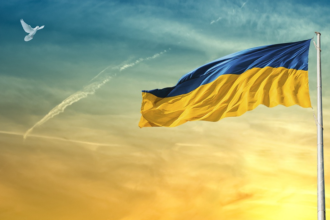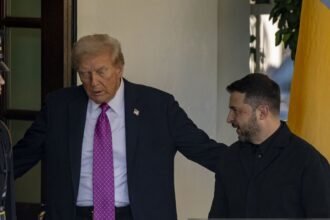What Is the Menacing Whirr Overhead?
- Who Are the Older Recruits Taking a Stand?
- What Does an Accelerated Training Schedule Look Like?
- What Is It Like Training Under the Shadow of War?
- What Happens on the Journey to the Border?
- What Is Ukraine's Gamble on Russian Soil?
- What Does Zelensky's Call for Help Look Like?
- How Are Exhausted Soldiers Coping on the Training Ground?
Russia’s suicide drones, passing above and then down on their targets, have dominated the menacing sound overhead for the previous seventy-two hours. But today, the buzzing comes from an uncrewed aircraft from Ukraine, one meant to transmit important footage from the training site back to commanders at the base rather than to kill.
Ukraine’s latest army intake is being fast-tracked to the battlefield at a covert training site in the Chernihiv area. It’s part of a fresh attempt to slow Moscow’s inevitable progress. One thing sticks out among the confusion of machine gun fire and loud commands: the recruiting age. Most of the troops under training are in their forties and fifty.
Who Are the Older Recruits Taking a Stand?
Among this gray-haired contingent is Rostyslav, a man whose wife and two children are back home in the Odessa area, and they are nervously waiting for him. He was a driver only one month ago. But next month, he might find himself fighting on Russian territory; Ukraine is determined to hang onto the territory it grabbed in the Kursk area during its lightning-fast attack.
Rostyslav, considering the procedure, adds, “I think this is the right thing to do.” “Look at their length of presence on our territory. We have to act; we have suffered for so long. You cannot simply lounge about while they are claiming our land. What, then, shall we do? Will we become their slaves?
What Does an Accelerated Training Schedule Look Like?
As Ukraine strives to offset the sheer quantity of Russian soldiers being dispatched to the frontline, the training program mirrors the quickened speed of the battle itself. According to current estimates by the British Ministry of Defence, May and June alone claimed 70,000 Russian losses in Ukraine.
Ukraine’s fresh recruits hop in and out of American-made armored combat vehicles and shoot at enemy positions under the unrelenting, sweltering heat. Anxious to keep this training facility secret, the military insisted on watching the on-site film to guarantee security.
While the echo of grenade target practice rattles over the terrain, nearby in a thick forest, a simulated Russian attack on Ukrainian positions is thwarted.
Two and a half years into this terrible conflict, Ukraine’s need for fresh soldiers is evident. Under a new conscription law, men’s draft age was dropped from 27 to 25. Although it is still non-mandatory, it is a military duty for women.
This specific batch of recruits reflects a different demography, even with the demand for younger conscripts. Every soldier here today has finished thirty days of basic training already. Their attention now is more complex medical treatment—learning to manage catastrophic bleeding, gunshot wounds, and fractured bones using equipment dispatched from the UK.
There is no escape from the dismal truth that the skills taught beneath the shadow of the spruce trees may soon be utilized on the battlefield; lighthearted events, such as when a tourniquet is too wonky, sometimes puncture the solemn atmosphere.
What Is It Like Training Under the Shadow of War?
One soldier who travels with the group is fast to protect the training program. “They won’t be sent to the frontline if the fresh intake lacks sufficient fighting ability,” he says sternly. “We are not going to forward them toward death.”
Even with this comfort, criticisms continue, especially from professional troops who claim that raw recruits have been dispatched to other fronts without sufficient preparation and pushed into battle too early. The stakes are high mainly while Ukraine battles on vital territory at home, most notably around the strategically significant city of Pokrovsk in Donetsk.
Still, last month’s bold attack on Russia raised spirits and gave the fight fresh dimensions. This new front symbolizes a significant personal bet for President Zelensky, whose generals now have tough strategic choices about where to put their soldiers.
Among the younger hires in this group is Maxim, a 30-year-old builder by trade. “We need to train, train, and train again,” he says unambiguously. We shall learn more here as we train. It will enable us to be on the front lines.
He responds with pride and anxiety when asked where he expects to be deployed: “We are ready to defend our land either in Donbas or Kursk.”
What Happens on the Journey to the Border?
Earlier in the journey, a military escort brought the party to a new Ukrainian outpost in the Sumy area, just a few miles from the Russian border. Streeting to pieces by past Russian artillery bombardment seemed barren along the road. Long since the people departed, the only visible human life was clad in green fatigues, operating military vehicles.
Fresh from the Kursk assault, an armored personnel carrier (APC) sprung to life and dashed out of its camp hiding spot. It turned and shot down a track lined with canopies, spewing a vast cloud of copper-colored dust behind it.
“We treated the Russian troops who turned themselves in as POWs. The Ukrainian commander, going by the call sign “Storm,” claims, “We killed the Russians that attacked us.” Initially entering Russian territory, his 22nd Mechanized Brigade has returned to share his experience.
We traveled deep into the Kursk area. The front team consisted only of us. We felt like strangers since we were on alien ground. Not in our house.”
A behemoth of a guy with a graying goatee and military tattoos on the flesh not covered by his fatigues and body armor, Storm, a father of five with five degrees, makes an unusual sight in the deep woodland. He displays a video of an APC speeding over the Russian countryside on his phone. With pride, “That’s us, in there.”
Storm answers honestly when asked what it was like fighting the Russians on their territory, “I feared for myself and my squad, for my guys, for everyone. Of course, there was terror.
Despite his openness, the storm is reluctant to divulge any operational information that would assist the Russians—just as many Ukrainian military men are. When asked how long he anticipates staying on Russian territory when he returns, his response is typically evasive but patriotic: “We are performing an order. We will stay as long as instructed. Should we be instructed to advance, we will do so. Should they advise us to back off, we will do so.”
Real Cossacks, he continues with tenacity, “If we have an order to move forward, we can get to Moscow—and we’ll show what Ukraine means and what our guys are like.”
What Is Ukraine's Gamble on Russian Soil?
According to reports, Ukraine’s fast push has dispatched up to 10,000 elite soldiers into Russia. Meanwhile, the Russian defense ministry claims Kyiv has suffered thousands of casualties. General Oleksandr Syrskyi, leader of the Ukrainian army, recently revealed that Russia has sent 30,000 troops to guard Kursk. All of these numbers are challenging to confirm.
A squad leaps out of a German-made Bergepanzer armored recovery truck at another secret site. Under the call sign “Producer,” the driver—a father of two—has not seen his kids in three years. Early in Russia’s full-scale invasion in February 2022, his family left for Italy with their mother. Although the degree of Ukrainian losses is unknown, the Producer has been occupied with rebuilding wrecked and damaged automobiles from within Russia.
He speaks fluent English and says, “I want this war to end. “This conflict has no justification for existence. One individual targeted our nation: Vladimir Putin. What, therefore, ought we to do? We must defend our house—support, defend, protect. Still, Ukraine is a smaller nation.
What Does Zelensky's Call for Help Look Like?
A significant issue is the discrepancy between Moscow and Kyiv’s resources. This disparity emphasizes President Zelensky’s persistent appeals for more Western help. Ukraine has energized its people by bringing the struggle right into Russia. Still, some of its friends are worried about Vladimir Putin’s erratic reaction and possibly a more significant confrontation.
Putin has so far mainly disregarded, at least publicly, the damage done to his nation. Unlike Russia, Ukraine lacks unlimited conscript reserves to send into combat. The sites shown reflected the deployment problem. President Zelensky contends that American and European aid with air defense is now more critical than ever. Mainly in Kyiv battles domestically and internationally, he also emphasizes the essential requirement of authority to utilize foreign-made long-range missiles to strike farther into Russia.
How Are Exhausted Soldiers Coping on the Training Ground?
The troops are tired as the squad prepares to depart the training field. Many are lying on the ground, water bottles and smoke in hand. Longing to return to Odessa, Rostyslav strongly thinks his president is correct.
“We lack a weapon to reach theirs; the Russians can reach our land with long-range weaponry. This is intolerable now,” he says. “We want to strike Moscow to end this filthy war. Children and citizens suffer, everyone does.”
Biden Greenlights ATACMS Missiles for Ukraine to Strike Inside Russia








